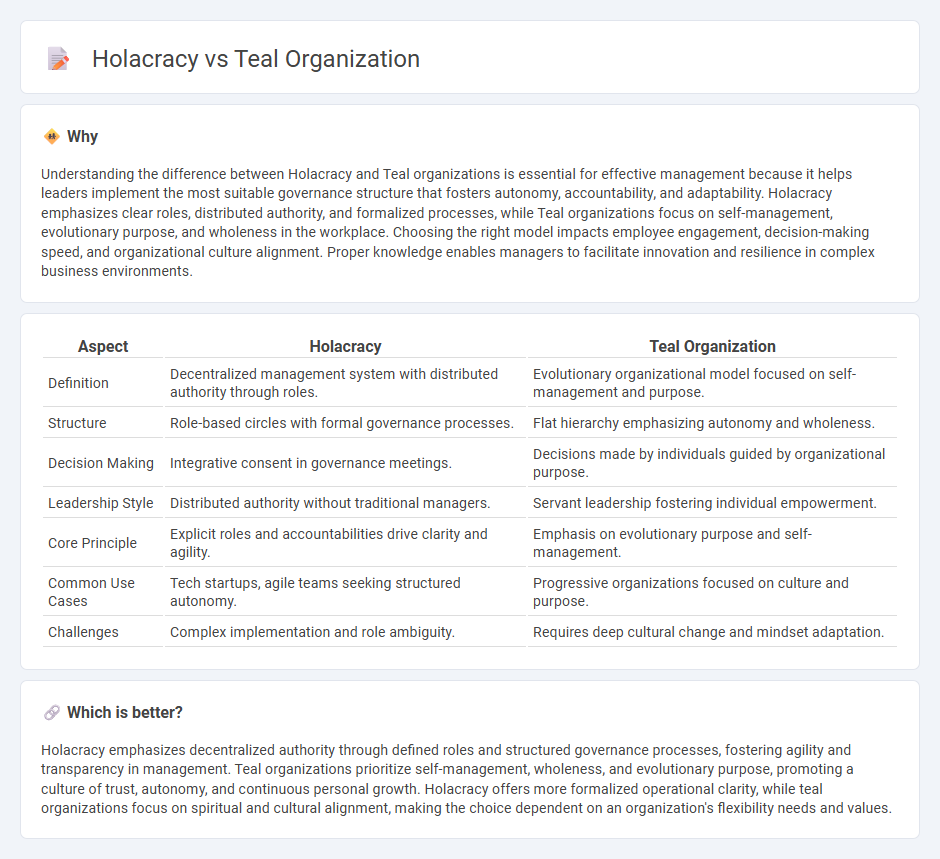
Holacracy replaces traditional management hierarchies with distributed authority and self-organizing teams, enabling dynamic role assignments and transparent governance. Teal organizations promote evolutionary purpose, wholeness, and decentralized decision-making through empowered individuals embracing self-management principles. Discover how these innovative management models transform organizational effectiveness and culture.
Why it is important
Understanding the difference between Holacracy and Teal organizations is essential for effective management because it helps leaders implement the most suitable governance structure that fosters autonomy, accountability, and adaptability. Holacracy emphasizes clear roles, distributed authority, and formalized processes, while Teal organizations focus on self-management, evolutionary purpose, and wholeness in the workplace. Choosing the right model impacts employee engagement, decision-making speed, and organizational culture alignment. Proper knowledge enables managers to facilitate innovation and resilience in complex business environments.
Comparison Table
| Aspect | Holacracy | Teal Organization |
|---|---|---|
| Definition | Decentralized management system with distributed authority through roles. | Evolutionary organizational model focused on self-management and purpose. |
| Structure | Role-based circles with formal governance processes. | Flat hierarchy emphasizing autonomy and wholeness. |
| Decision Making | Integrative consent in governance meetings. | Decisions made by individuals guided by organizational purpose. |
| Leadership Style | Distributed authority without traditional managers. | Servant leadership fostering individual empowerment. |
| Core Principle | Explicit roles and accountabilities drive clarity and agility. | Emphasis on evolutionary purpose and self-management. |
| Common Use Cases | Tech startups, agile teams seeking structured autonomy. | Progressive organizations focused on culture and purpose. |
| Challenges | Complex implementation and role ambiguity. | Requires deep cultural change and mindset adaptation. |
Which is better?
Holacracy emphasizes decentralized authority through defined roles and structured governance processes, fostering agility and transparency in management. Teal organizations prioritize self-management, wholeness, and evolutionary purpose, promoting a culture of trust, autonomy, and continuous personal growth. Holacracy offers more formalized operational clarity, while teal organizations focus on spiritual and cultural alignment, making the choice dependent on an organization's flexibility needs and values.
Connection
Holacracy and teal organizations both emphasize decentralized decision-making, empowering employees with autonomy and self-management to foster agile and resilient work environments. Holacracy provides a structured framework with defined roles and governance meetings, aligning with the teal principle of evolutionary purpose and collective intelligence. Both approaches reject traditional hierarchical management, promoting transparency, distributed authority, and adaptive organizational culture.
Key Terms
**Teal Organization:**
Teal organizations embody self-management, wholeness, and evolutionary purpose, emphasizing decentralized decision-making without traditional hierarchies. They foster environments where employees bring their whole selves to work, enabling adaptive and purpose-driven growth beyond fixed roles. Explore the transformative principles behind teal organizations and how they can revolutionize workplace culture.
Evolutionary Purpose
Teal organizations and holacracy both emphasize evolutionary purpose as a core principle, guiding decision-making and individual roles toward the organization's ongoing development. Teal organizations embrace self-management and wholeness supported by a deeper sense of purpose that evolves organically. Explore these frameworks further to understand how evolutionary purpose drives innovative and adaptive organizational structures.
Self-Management
Teal organizations emphasize evolutionary purpose and self-management by distributing authority and encouraging employee autonomy to foster innovation and responsiveness. Holacracy implements self-management through a formalized governance structure with defined roles, circles, and explicit rules to ensure clarity and accountability. Explore how these approaches empower teams to enhance productivity and organizational agility.
Source and External Links
Teal organisation - Teal organizations are characterized by self-management, wholeness, and evolutionary purpose, replacing traditional hierarchy with worker autonomy and collaborative decision-making.
Teal Paradigm and Organizations - In teal organizations, hierarchical structures are replaced by self-managing teams that adapt rapidly and guide their actions by listening to the organization's purpose rather than following top-down commands.
TEAL Organisations | The management style of the future - TEAL organizations decentralize decision-making, value employees' emotional well-being and personal growth, and see themselves as evolving entities driven by purpose rather than rigid plans or hierarchies.
 dowidth.com
dowidth.com